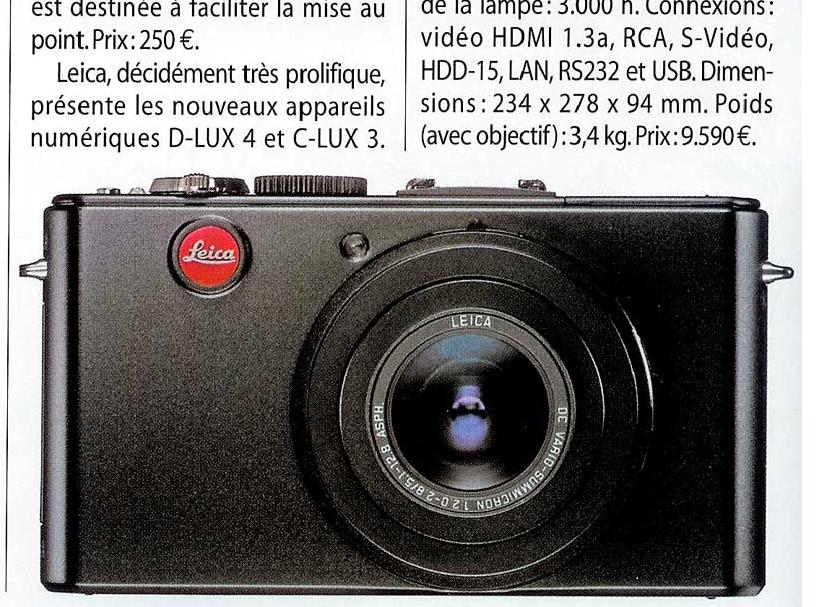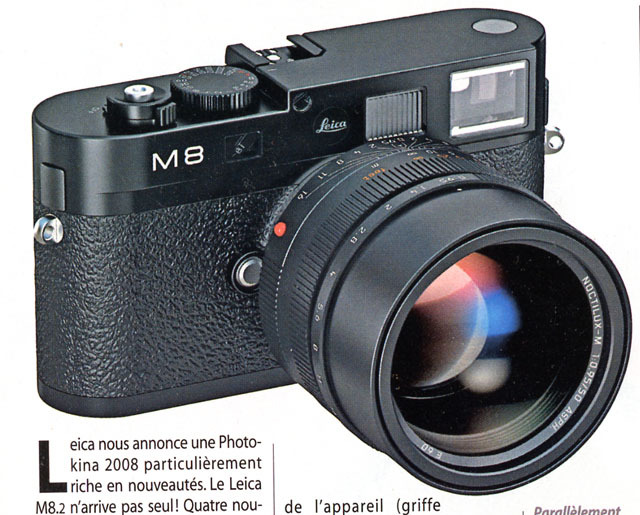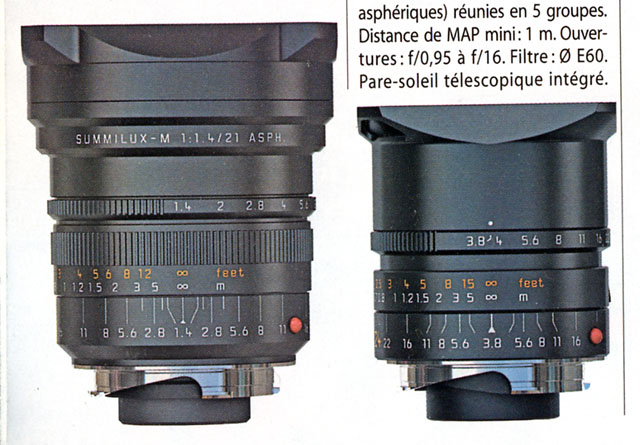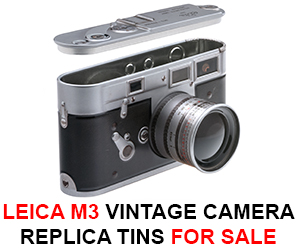Specifications LEICA M8 (LEICA M8.2)
Camera type: Compact digital camera viewfinder system for professional use
with Leica M lenses. Microprocessors-controlled metal blade focal plane shutter.
Image sensors: Low-noise CCD sensor specially optimized for the requirements of
the M lens system. Pixels: 10.3 million. Dimensions: 18 mm x 27 mm. Extension
factor: 1.33 x. Aspect ratio 3:2. Coverglass thickness 0.5 mm, complete suppression
of infrared light by additional UV / IR filter. Moir filter: no, but full
exploitation of the lens capabilities by Moir fringe detection and elimination
by digital signal processing.
Sensor speed range: Manual setting from ISO 160/23 to ISO 2500/35
LEICA M8.2: additional automatic setting with free choice of ISO range.
Viewfinder
Viewfinder principle: Large bright-line frame viewfinder with automatic parallax
compensation. Viewfinder optics with reduced sensitivity to stray light and
optimum visibility of the bright-line frame in all lighting situations
Eyepiece: Matched to-0.5dpt. Correction lenses from -3 to +3 dpt
available.
Image framing: By display of two bright-line frames at a time: for 24 and 35 mm;
or for 28 and 90 mm, or for 50 and 75 mm. Display selection automatically matches
the lens in use. 100% of the sensor format is covered at 0.7 m (LEICA M8.2: 2 m)
Frame selector: Displays pairs of frames manually to simulate any focal length
Parallax
compensation: The horizontal and vertical difference between viewfinder and lens
is compensated appropriately for the focus setting, ie the bright-line frame of
the viewfinder automatically coincides with the subject area as seen from the
lens.
Magnification: 0.68 x (for all lenses).
Wide-base Combination of split-and superimposed-image rangefinder
rangefinder: shown as a bright field in the center of the viewfinder image.
Effective base measuring 47.1 mm (mechanical measuring base 69.25mm x viewfinder
Magnification 0.68 x).
Lenser
Lens mount: Leica M bayonet with additional optical sensing for the identification of
all 6-bit coded lenses.
Lens system: Current 6-bit coded Leica M lenses of 16 – 90 mm focal length.
All Leica M lenses of 21 – 90 mm focal length produced since the year 1954 can be
used, even if lacking the 6-bit coding. Virtually all lenses can be retrofitted
with 6-bit coding.
6-bit functions: Lens-dependent reduction of edge shadowing originating in the
system. Identification of the lens information within the image file to
facilitate digital archiving. Adjustment of the flash reflectors when using engine
zoom flash devices. Auto slow sync. function in aperture priority mode.
Compensation of color shifts through the use of UV / IR filters.
Exposure control
Aperture priority mode
(Auto): Automatic determination of the correct shutter speed with manual aperture
pre-selection and corresponding viewfinder display.
Manual exposure
control: Free selection of shutter speed and aperture – can be visually checked
using the exposure control in the camera seen by LED light in the balance
viewfinder.
(Snapshot mode: “S” setting of shutter speed dial = automatic control of exposure
time, ISO speed and white balance. Menus reduced to essential functions, hints on
aperture and focus settings are displayed when the Info key is pressed.
Picture modes
S Single picture, pressing the shutter release once per picture
C Continuous succession of pictures with 2 pictures per second and 10 pictures in
the sequence.
Auto-release: Selectable with 2sec. and 12sec. delay time – visualization of the
countdown by an LED visible from the front of the camera in the viewfinder
window.
Controls / displays
Camera front: Lens mount; frame selector
Top: Main switch (more pronounced detent mechanism to prevent inadvertent
switching) and shutter release; shutter speed dial, LCD status display: display
of remaining exposures and battery capacity.
Back: 2.5 “color monitor (scratch-resistant sapphire coverglass), dial for
navigation in the menu & magnifier function in 4 steps; 4-way direction pad for
navigation in the menu & in picture details; menu button; play button; delete
button; protect button; info button
Base: Lockable base plate protects the rechargeable battery and the SD memory
card against dust and moisture.
Color monitor 2.5 “large bright LCD display with a resolution of about 230000
pixels for viewing pictures and the menu settings (scratch-resistant sapphire
coverglass). Brightness control in 5 stages. Checking options after taking the
picture: general quality assessment, checking the exposure by means of a RGB
tonal value histogram with identification of bright picture areas lacking detail
(can also be used when zooming in), checking the focal plane, display of the
quality parameter settings and the focal length of the lens (when used with
current 6-bit coded lenses)
Picture view sizes: 9 miniatures, 4 miniatures, full picture display and
enlargement in four stages up to 100% view (1 sensor pixel = 1 display pixel).
Picture parameter menu – main menu
By pressing the button set, the following parameters relevant to the picture can
be selected and changed in the picture parameter menu: user profile, sensor
speed, manual exposure correction, white balance, image data format, picture
resolution.
By pressing the menu button, parameters such as the color monitor contrast or the
color space can be set in the main menu.
Menu languages: German, English, French, Spanish, Italian, Japanese, Chinese.
Picture resolutions: DNG: 3916 x 2634 pixels (10.31 MP); JPG: 3936 x 2630
pixels (10.35 MP), 2952 x 1972 pixels (5.8 MP), 1968 x 1315 pixels (2.6 MP), 1312
x 876 pixels (1.15 MP).
Data formats: DNG (camera manufacturer-independent digital negative format), 2
different JPEG compression rates
DNG file 16-bit color resolution, 10.2 MByte file size per picture
information:
Memory media: SD and Mini SD cards up to 32 GByte
Complete list of LEICA M8-and M8.2-compatible SD memory cards:www.leica
camera.de/photography/m_system/m8
White balance: Automatic, 6 preset values, manual white balance, color
temperature input from 2000K to 13.100 K.
Color spaces: Adobe RGB, sRGB, ECI RGB.
Viewfinder display: (at the bottom edge of the viewfinder)
LED symbol for flash status, four-digit seven-segment LED display with dots above
and below (display brightness is always adjusted to ambient brightness) for
display of the automatically calculated shutter speed in aperture priority mode,
indication of the use of saved metering values, warning of exposure corrections,
warning of when the metering range is overshot or undershot in aperture priority
mode and countdown display of shutter times longer than 2 sec., memory capacity
warning when the SD card is full.
LED light balance with two triangular and one central circular LED for the manual
exposure setting.
Display of: underexposure by at least one aperture stop; underexposure by 1 / 2
aperture stop; correct exposure; overexposure by 1 / 2 aperture stop;
overexposure by at least one aperture stop.
Triangular LEDs give the direction of rotation of the aperture setting ring and
shutter speed setting dial to adjust the exposure. The LED flashes as a warning
that the metering range is overshot or undershot.
(In “S” mode: red dot to indicate correct exposure, left arrow to warn against
camera shake, right arrow to warn against overexposure)
Exposure metering: Heavily center-weighted TTL exposure metering with pre –
set working aperture.
Metering principle: Light reflected from a white strip in the centre of the metal
blade focal plane shutter.
Metering range: EV0 to EV20 at 20 C room temperature, 1.0 aperture and ISO
160/23.
Metering cell: Silicon photodiode with collection lens positioned at the center
of the lower edge of the camera base.
Flash exposure metering / control using M-TTL flash technology
Principle: Using an extremely short calibration pre-flash fired immediately
before the exposure, the exact power requirement for the main flash is
determined.
Connection: M-TTL guide number control with calibration pre-flash at
accessory shoe SCA 3502 (version M4) or with Leica flash SF24D
Flash synchronization
time: 1 / 250 sec. (1 / 180 sec.) Synchronization permits creative open aperture
photography even in bright ambient light.
Manual: Flash synchronization times from B (bulb) down to 1 / 250 sec. (1 / 180 sec.)
Aperture priority mode: Auto Slow Sync: automatic extension of the longest flash
time, using the rule of thumb 1/focal length in seconds. (only with 6-bit coded
lenses). Choice of long flash synchronization times up to I 1 / 8 sec. for
balanced flash when taking pictures in available light aperture priority mode.
Synchronization Firing optionally at the 1st or 2nd shutter point (with
flash firing time: appropriate flash device such as the LEICA SF24D or when using
the SCA-3502 adapter).
Flash exposure ± 3 1 / 3 EV in 1 / 3 EV stages adjustable at the SCA –
correction: 3501/3502 adapter. Settable at the LEICA SF 24D ± 3EV in 1 / 3
EV stages, or from 0 to -3 EV in 1EV stages when using computer control.
Shutter and shutter release
Shutter: Microprocessors-controlled metal blade focal plane shutter with vertical
action (optimized to reduce noise and vibration).
Shutter times: In aperture priority mode (A) steplessly adjustable from 32 s down
to 1 / 8000 s (1 / 4000 s). With manual setting from 4 s down to 1 / 8000 s (1 / 4000 s)
in half steps. B for long exposures of any length.
Activation: Shutter activation optimized for a minimum of noise. Electric motor
drive with friction wheel in the first speed build-up stage and a cam disk for
homogenous torque throughout the activation process (time-delayed after cocking
shutter button is released, selectable in menu).
Release: Three-stage activation governed by how far the release is
depressed: 1. Switch the camera electronics on & activate the exposure metering –
2. Save metered value (in aperture priority mode) – 3. Release (includes a
standard thread for the cable release)
Power supply: Lithium ion rechargeable battery with a nominal voltage of 3.7 V
and a capacity of 1900mAh.
Interface: 5-pin standard mini-USB socket on the left side of the body, for quick
USB 2.0 data transfer to a computer.
Camera body
Material: Enclosed all-metal body of highly stable magnesium alloy for
professional use over many years. Black synthetic leather coating. Top cap and
base plate are milled from solid brass and are silver or black chromium plated
(black paint finished).
Tripod thread: DIN4503 – A1 / 4 (1 / 4 “) in the centre of the bottom cover.
Size (W H x x D): 138.6 mm x 80.2 mm x 36.9 mm
Weight without battery: approx. 545 g
Scope of supply: M8 camera (10702 silver or black 10701),
M8.2 camera (10712 silver or black 10711),
anti-slip carrying strap (14 312), camera cap for the M bayonet (14 195),
rechargeable lithium ion battery (14 464), battery charger incl car socket
adaptor and 3 mains plug adapters (Euro, UK, USA) (14 463), (compact charger with
80% charge display, car socket and EURO / USA mains leads), USB connection cable,
user manual, software DVD Capture One 4, warranty card.

















